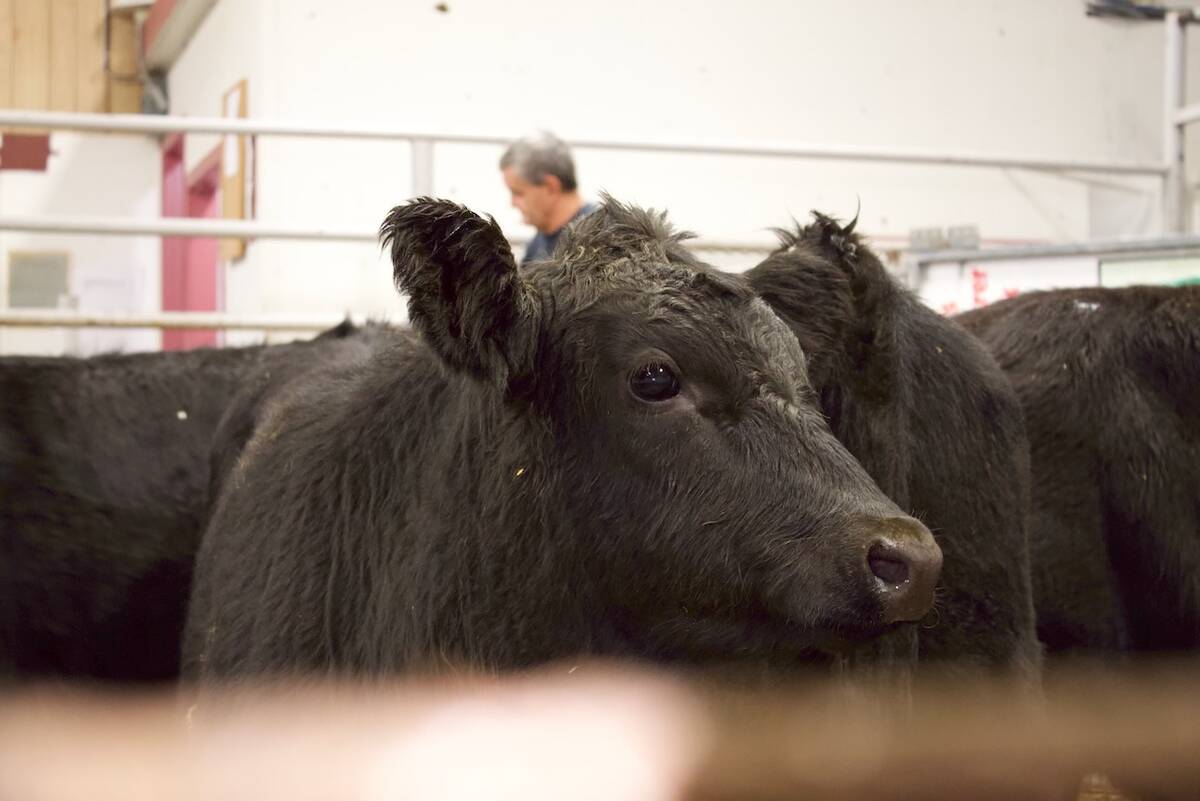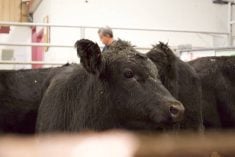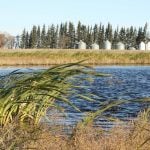November 26
Last Thursday morning it was snowing hard. Michael called to tell us he was worried about Andrea and me trying to take our trailer to the bull sale Montana the next day. We’d have to chain up the truck and trailer to make it over two of the passes. We realized another problem would be the cold weather — it was predicted to be -35 C at Three Forks, Montana and -25 C here)
Andrea’s diesel pickup would need to be plugged in. We called the hotel where we’d be staying and they didn’t have any way we could plug in a vehicle. We decided to take Andrea’s car instead; it has good tires and starts in cold weather. A purchased bull could be delivered to a sale yard near Dillon, Montana (just over the mountain from us — only a three-hour drive). We could get him later and not need to have Andrea’s truck plugged in overnight.
Read Also

Cattle market grinds lower in December
Fed cattle suppliers are weighing on cattle markets across North America and that’s meant lower beef markets.
That afternoon and evening we got everything ready for our trip, with lots of warm clothes, and I cooked some things Lynn could have for meals while I was gone. Friday morning it was -20 C when I went out in the dark to do chores and get ready to leave. We got to the stockyard near Three Forks late in the morning. We walked around looking at bulls and making notes until we got too cold, then drove 10 miles to the hotel. We met other folks who’d come to the sale — buyers and some of the people who raise bulls for Pharo Cattle Company. I met Kit Pharo; I’ve interviewed him for articles and known him for more than 20 years, but had never actually met.
At the sale the next day we managed to buy a bull, though the first 18 we liked were way out of our price range. The one we bought is a very mellow fellow; our main criteria for selection were calving ease and disposition. His registered name is Jurassic Park but we nicknamed him Barney — the friendly purple dinosaur.
We took our trailer over the mountain to Dillon on Monday to pick up the bull. Even though it’s only 100 miles from here, it’s a slow trip over Bannock Pass with 15 miles of rough gravel road. When we got home and unloaded Barney into the pen with the older bull, they were instantly buddies and got along just fine.
Today we had a family get-together for belated Thanksgiving dinner at Andrea’s house, since this was the day her kids could be there (except Sam, who couldn’t get off work in Twin Falls). We also invited Nick, so Lynn and I had four of our grandkids there.

December 5
Last Sunday was windy and I did evening chores in a blizzard. The next day Andrea helped me get a load of little bales from my hay shed to stack by the gate to the heifer pasture. I’ll continue feeding the weaned heifers some grass hay twice a day (plus a sled full of alfalfa every morning). They are doing OK with that ration but we’ll soon give them more hay. Andrea checked on the bred heifers in the lower back field. They are still grazing the rough feed sticking up above the six-inch-deep snow.
Thursday Michael and Carolyn drove to Jackson, Montana for a mini excavator. He’s been periodically renting one for some fencing jobs, and spent enough in rent over the past few years that he could have purchased one. He found a used one in Jackson that will work better than the one he had to rent. It was a rough trip, with snowstorm and bad roads — eight inches of new snow on the passes. He had to chain up truck and trailer for about 50 miles each way. They finally got home late that evening.
With the new snow we thought we might have to start feeding hay or plow driveways, so Lynn plugged in the tractor that evening, but we only had about three inches of new snow here. The cows were still able to graze, but we took protein blocks to the bred heifers in the lower back field. The protein will stimulate them to eat more of the rough feed that they can still get to.
The gate to the lower field was impossible to open, with wooden uprights frozen into thick ice where the spring flooded into that lane. But Andrea’s four-wheeler fit through the small space between the gate post and the first upright (we could open it that much) to take protein blocks to those heifers. Then she and Lynn took a big bale of straw to the cows, putting it in the brush at the edge of their field where they like to bed. They can bed in the straw and eat some.
Andrea called us Saturday afternoon to tell us the old house that Dani and Roger are living in was on fire. Dani had come home from work (she works part days on Saturday) and was taking a nap when Roger came home and discovered the smoke and woke Dani, and they got out OK.
The fire started in old wiring in the attic and burned through the ceiling into the laundry room. The fire crew broke a hole into the front of the house and were able to get the fire out within a few hours, then allowed friends and family to go in briefly and get as much stuff out as they could salvage, though much was damaged by smoke and water. Andrea took their clothes home to wash, and filled the back of her truck with other belongings. Dani’s dad and Charlie filled their trucks and neighbours helped, too. The bed and couch will need to be cleaned before they can be used again. The house was destroyed, so they are staying temporarily at her dad’s house.
Today was a little warmer but it snowed again. Dani and Roger came to Andrea’s house to get some of their things and some clothes Andrea washed, so Dani would have something clean to wear to work.
December 14
Last Tuesday we started feeding the weaned heifers big alfalfa bales. Andrea pulled the bale feeder out to their field with her four-wheeler, and we cut the deer netting and made a “gate” we can open to get into those stacks. Lynn was able to get a big square bale (first-cut alfalfa) from the stackyard and put next to the corner of the corral where I’ll be feeding the weanling bulls this the winter.
The second-cutting alfalfa we gave to the heifers was pretty rich — mostly leaves — and we hoped they wouldn’t bloat. They were somewhat adjusted to eating alfalfa with the flakes I’d been giving them daily for more than a week, but it wasn’t this rich. I checked on them a few hours after we gave them the big bale; they were all very full and a bit bloated, but none in danger of fatal bloat. I checked them again just before dark, and they seemed OK.
Weather continued cold, and the straight alfalfa wasn’t adequate for generating body heat (ruminant animals need more roughage for that) so I’ve been giving those heifers a little grass hay in the evenings.
We had more snow on Friday. The cows and bred heifers were still able to graze, but we gave them more protein blocks. Water for the heifers in the lower back field was becoming an issue. About the only places they could drink were some little spots where a spring comes out of a patch of brush on the hill.
Sunday was the warmest day we’d had for a long time (above freezing!) so we decided to vaccinate the bred heifers (first scour vaccine, so they can have a booster shot before calving when we give the cows their annual booster). The heifers need a two-shot series of the vaccine to help them create antibodies against E. coli, rotavirus and coronavirus in their colostrum and give their calves protection against those common pathogens.
Charlie, Dani and Roger came out to help, after Andrea and I got the heifers safely across the ice in the gateway out of the lower field. We vaccinated them and put them with the cows in the field by her house. We also sorted the two little bulls out of the weaned heifer group and put them in the main corral for winter.
The next day we realized those little guys were too timid to step down into the creek for water, where we’d broken a water hole; they were eating snow instead. So we let them into the old “water gap” in the brush behind the chute, where the ice was easy to break and the bank not so steep. They are happily drinking there, and can use that sheltered area in the brush as a windbreak during winter storms.















